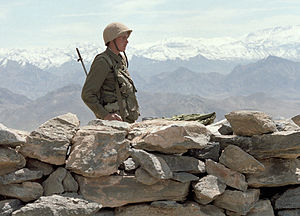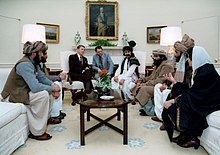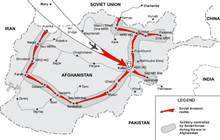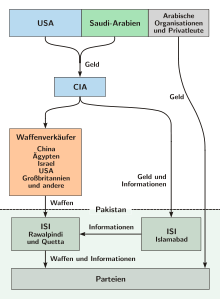Soviet–Afghan War
Soviet intervention in Afghanistan
Part of: Cold War

Soviet soldier patrolling a road in Afghanistan, 1988.
The Soviet intervention in Afghanistan (Pashto په افغانستان کې شوروی جګړه, Persian جنگ شوروی در افغانستان, DMG Ğang-i Šouravī dar Afġānistān, 'War of the Soviet Union in Afghanistan'; Russian Афганская война Afganskaya voyna, German 'Afghan War') took place between 1979 and 1989. It began with the Soviet Union providing military support to the Afghan rulers, who had come to power in a coup, against the numerous Mujahideen factions that formed primarily in reaction to the secularization of Afghanistan. These Islamist rebel groups were subsequently supported politically and materially by the United States as well as some NATO countries and parts of the Islamic world. The invasion and assassination of the head of government, Hafizullah Amin, was intended to "stabilize" the government of the Democratic Republic of Afghanistan (DRA). It was also intended to stop further meetings between Amin and US diplomats and to prevent an Islamic revolution along the lines of Iran.
History
Afghan Civil War until 1979
After the coup d'état by the communist People's Democratic Party of Afghanistan (DVPA) under Nur Muhammad Taraki on April 27, 1978, through the Saur Revolution, the latter pursued a rapprochement with the Eastern Bloc in order to advance social transformation (expropriations for land reform).
In particular, the forced secularization and the disempowerment and partial murder of the upper class quickly led to widespread resistance among the population. Around 30 Islamist Mujahideen groups were founded during this period. Moreover, there were also political disputes and power struggles within the DVPA. With the assassination of Prime Minister Nur Muhammad Taraki in September 1979, Hafizullah Amin took power and attempted to quell the resistance. As a result, the civil war escalated, which was soon supported and financed by the CIA.
Taraki had repeatedly and urgently requested Soviet military aid to combat internal unrest since late 1978. At the time, the Soviet Union refused military aid, in part because of the high foreign policy risk. However, as the KGB now feared that Amin might lean on the West and call NATO troops into the country to secure his power, voices were growing within the USSR leadership in favor of a temporary military intervention. When relations with the West reached a new low after the NATO double decision of 12 December 1979, this position prevailed, and so Leonid IlyichBrezhnev gave the order for deployment. However, this was not an expression of the Brezhnev Doctrine, by which the Soviet Union granted itself the right to intervene in socialist states. Afghanistan under the Taraki regime was not considered a socialist state, but only a "state of socialist orientation".
The motive for the intervention is said to be concern for the Muslim population of the southern Soviet republics, which could possibly be infected by the uprising of the Afghan resistance groups. It is also believed that the Soviet Union's strategic goal in doing so was to penetrate as far as the Indian Ocean. The German political scientist Helmut Hubel, on the other hand, argues that the Soviet leadership, from a position of its own strength, would have been concerned with defending its position of power, which it already believed to be secure, and keeping Afghanistan in its sphere of influence.
Soviet invasion
On December 25, 1979, the first units of the Soviet 40th Army under Marshal Sergei Sokolov, newly formed for the Afghanistan mission, the 5th and 108th Motorized Rifle Divisions, crossed the border into Afghanistan at Termiz and Kushka. At the same time, 7000 elite troops of the 103rd Vitebsk Airborne Division were flown into Kabul and Bagram. On the first day of the invasion, a crash of an Il-76 military transport plane on a mountain near Kanzak (northeast of Kabul) killed the pilot, 37 paratroopers and nine other soldiers.
On 27 December, KGB special forces who had been in the country for some time, supported by paratroopers, carried out Operation Storm-333 by storming Tajbeg Palace and other operationally important points in Kabul and killing Amin. The previous Afghan leadership was eliminated in one fell swoop, political prisoners were freed, and on the same day a radio announcement was made that Babrak Karmal had taken over the government. There was little resistance from the Afghan army, and most commanders, under the influence of the Soviet military advisers who had been placed at their side, soon agreed to cooperate with the new government. The latter tried on the one hand to de-escalate the civil war and on the other hand to strengthen ties with the Soviet Union, among other things through an agreement on the stationing of troops.
The Limited Contingent of Soviet troops in Afghanistan (official designation; Russian. Ограниченный контингент советских войск в Афганистане, OКСВА) comprised 85,000 troops as early as February 1980. The troop strength was further increased to about 115,000 by 1988.
International reaction
The military intervention was immediately condemned by Western and Islamic states. It overshadowed the 1980 Summer Olympics (Moscow/Tallinn), which were boycotted by many states as a result.
Military resistance
About two-thirds of the Afghan army joined the resistance against the Soviets. The conservative mujahideen received increasing international support. On March 21, 1980, the Islamic Alliance for the Freedom of Afghanistan was founded as an alliance of Islamist and monarchist groups. These were at odds with each other and cooperation was limited to fighting communist rule. The war was waged ruthlessly and cruelly by both sides; war crimes were committed by the Soviets and government forces as well as the Mujahideen.
The fight against the Soviet invaders and the Communist government was led in particular by an alliance of seven Islamic parties, which had their common general staff in Pakistan and were at odds with each other. The leaders of these parties were also called warlords ("warlord") by the Western press. Pakistan, which intensively supported the Islamist warlord Hekmatyar in particular and pursued its own interests in the neighboring country, was the most important ally of the anti-communist forces along with the USA.
The Soviet and Afghan government forces, despite their military superiority and air superiority, failed to break the resistance of the mujahideen. Although they were able to quickly occupy important towns and roads in the valleys, they had no control over large areas outside the major cities. A military stalemate was finally reached in 1982, while the fighting on both sides became increasingly brutal. The Soviet army responded to the guerrilla tactics of the mujahideen in hunting battles, who generally took no prisoners, by, among other things, terrorizing the civilian population. A turning point in the ongoing conflict did not come until 1985 with the election of Mikhail Gorbachev as the new General Secretary of the CPSU, who had taken office promising to end the war in Afghanistan. This at a time when the Soviets had begun to move their troops by transport helicopter as well as troop-carrying Mil Mi-24s into combat zones in the country so as not to have to fight the rebels from below. After the first such successes, the Soviet troops lost the possibility of such air transports as a result of the CIA's delivery of state-of-the-art Stinger missiles to the mujahideen. The Soviet leadership came to the realization that the war could not be won and henceforth sought a way to withdraw its troops from the country without losing face.
In May 1986, Mohammed Najibullāh replaced Karmal as head of government and attempted to defuse the war through negotiations. Babrak Karmal, however, remained chairman of the Revolutionary Council and thus head of state until November 20, 1986.
Retreat of the Soviet troops
The indirect negotiations between Afghanistan and Pakistan, which began in Geneva in 1982 and were mediated by the United Nations, led to the signing of the Geneva Agreement on 14 April 1988, which provided for the normalisation of relations between the two states and non-interference in each other's internal affairs. Complementary agreement was reached on the return of Afghan refugees who were in Pakistan. The Soviet Union and the United States guaranteed the renunciation of any interference in the internal affairs of Afghanistan. The withdrawal of Soviet troops was to be completed by mid-February 1989. The mujahideen rejected the agreement, which came into force on May 15, 1988, and also refused to participate in the coalition government under Najibullāh. As of May 15, 1988, the Soviet Union began withdrawing its official 100,300 troops from Afghanistan. According to journalist Sawik Schuster, Gorbachev had insisted on a UN guarantee that no Mujadehin soldiers would be killed during the withdrawal of troops. In a secret mission of the UN, Shuster was in Afghanistan in April 1988 and received the promise demanded by Gorbachev from the united commanders one week before the signing of the Geneva Agreement. However, due to further attacks by the Mujahideen, the Soviet soldiers were again engaged in fighting in July 1988, an account which Schuster strongly contradicted; "never" would shots have been fired from the guard posts which the Mujahideen had set up along the road from Kabul to Termiz. On the contrary, the Soviets had broken their promise when as many as two thousand civilians were killed in Operation Typhoon beginning on January 23, 1989. Dead civilians had been laid as charges on the road where the troop withdrawal took place.
By February 15, 1989, the withdrawal was over. Afghanistan had suffered over one million casualties, and five million people had fled the country because of the war. On the Soviet side, about 13,000 soldiers died in the more than nine years of war; according to later figures from the Russian General Staff, there were over 26,000 dead on the Soviet side.
The road to the new civil war
→ Main article: Afghan civil war (1989-2001)
The withdrawal of Soviet troops left Afghanistan politically and militarily without order. Like the heterogeneous resistance, the government of Mohammed Najibullah was unable to establish a claim to leadership and form a government that was accepted by the majority of the population. As early as January 1989, Kabul, which had been encircled by the mujahideen, was supplied only by a Soviet airlift. The anti-communist resistance organizations formed a counter-government in Peshawar, Pakistan, in February 1989. After the withdrawal of the last Soviet soldier on February 15, 1989, the Soviet Union initially provided material support to the leadership in Kabul. Since the Geneva Agreement only regulated the withdrawal of the armed forces, numerous Soviet advisers remained in Kabul. By the summer, the battle for Jalalabad was raging, in which the Mujahideen groups were unsuccessful. The mujahideen, particularly their largest parties, Hizb-i Islāmī and Jamiat-i Eslami-ye Afghanistan under Burhānuddin Rabbāni, became entangled in fighting among themselves that continued for years. In the spring of 1990, the then Minister of War, Nawaz Tanai, attempted a coup against Najibullāh. This failed and political purges followed. Nevertheless, as a result of increasing resistance, the ruling communist party relinquished its monopoly on power in June 1990 and renamed itself the "Home Party" ("Watan").
By the spring of 1992, the Mujahideen had taken military control of most of Afghanistan. On April 16, 1992, Najibullāh relinquished power through UN mediation after Russia, as the successor state to the USSR, reached an agreement with the USA to end their respective military aid and agreed to accept an Islamic government in Afghanistan. A council of four from Najibullāh's Watan Party assumed political leadership. On April 25, 1992, Kabul was handed over to the mujahideen without a fight and divided into six spheres of influence whose borders were mined. The mujahideen also took over all the remaining cities and garrisons in the area in the following days. However, the various Mujahideen factions began fighting each other immediately after the capture of Kabul. Another civil war broke out.
The fundamentalist Taliban finally emerged victorious from the ensuing conflicts, which met with little interest in the West, and established an Islamist state of God.

Armed Mujahideen in a destroyed village, 1988

Mujahideen armed with a Strela-2-MANPADS

Ronald Reagan with Mujahideen, 1983

Speznas troops interrogating a captured mujahid

Course of the invasion

Vehicles of the 5th Company of the 350th Soviet Airborne Regiment
Role of the individual states
Pakistan
At the time of the invasion of the Soviet troops, an Islamist military government under Mohammed Zia-ul-Haq existed in Pakistan. Pakistan felt threatened in its existence by the Soviet Union advancing towards Afghanistan in the west and the Soviet ally India in the east and wanted to prevent a possible coordinated attack by the two hegemonic powers. Both the defense of Islam and the Pakistani state played a role in this. Zia tasked the Director General of Intelligence, General Akhtar Abdur Rahman Shaheed, who was considered the second highest authority in the country, to work out possible solutions and eventually decided to secretly support the Mujahideen. Zia hoped for support from the Arab world as fighters for Islam and from the West as opponents of communism.
Even before the war began, Afghan Islamist parties in conflict with the secular-oriented Afghan government of Mohammed Daoud Khan settled in Peshawar, Pakistan. With the Soviet invasion, Pakistan stepped up its efforts to support the Sunni resistance. Seven mujahideen groups selected by Pakistan were allowed to settle in Pakistan. Pakistan's Inter-Services Intelligence (ISI) took charge of organizing and training the various mujahideen groups, distributing weapons and other resources as a middleman, and strategically planning the war. In the process, Pakistan employed the "strategy of a thousand pinpricks," which consisted of destabilizing the enemy through a large number of guerrilla attacks. Officials have always denied Pakistan's role in the Afghan war.
The ISI base from which the Afghan war was directed was the Ojhri camp in the north of Rawalpindi. In addition to a camp through which 70% of the weapons passed, there was also a training camp with simulators, which was later used in particular for the Stinger missiles, and a unit for psychological warfare. Other ISI camps were located near the mujahideen quarters in Peshawar and Quetta, among other places. From 1984 to 1987, over 80,000 mujahideen underwent weapons training in Pakistani camps.
United States
See also: Operation Cyclone
The National Security Advisor to US President Jimmy Carter, Zbigniew Brzeziński, states that Carter, by recommending support for the Mujahideen, increased the likelihood that the Soviet Union would fall into what he later called the "Afghan trap". The account that the Soviets were lured into such a trap, however, is rejected by contemporary witnesses as "not fact-based".
In the early months of the war, the United States Department of Defense and the CIA were reluctant to support Zia, since control of Afghanistan by the Soviet Union seemed inevitable in the near future. In fact, after the capture of Kabul, the new regime was recognized by the United States by sending Ambassador Adolph Dubs to the Afghan capital as a diplomatic representative.
Leading members of the CIA, however, including its director William Joseph Casey, soon saw war not only as an opportunity to fight communism in general. It was an opportunity in Afghanistan to make people forget the lost Vietnam War. The CIA's role was both to provide weapons and to assist Pakistan through intelligence such as satellite imagery and intercepted Soviet Army radio transmissions. The weapons came from China, Egypt, Israel, the US, Britain and other countries. They were supplied by the CIA to Pakistan, from where the ISI distributed them to the bases of the mujahideen leaders. The total financial volume of US support was between two and six billion US dollars.
Saudi Arabia
Saudi Arabia had supported the Sunni mujahideen since 1980. The country doubled the financial support of the mujahideen from the United States. In addition, Saudi Arabia financed the participation in the war of Islamist extremists who were in opposition to the Saudi royal family.
Iran
Iran took in about 1.7 to 2.2 million Afghan refugees. The country supported the Shiite mujahideen. Since Iran was in the First Gulf War during the Soviet-Afghan War, support from Iran remained low. At Iran's urging, the Shiite mujahideen parties united in 1989.
Federal Republic of Germany
The German government doubled development aid to Pakistan in 1980 and provided some DM 60 million for refugee relief in 1981. Afghan Mujahideen leaders were received in the FRG, among them the rather royalist-moderate Ahmed Gailani and Gulbuddin Hekmatyār of the Islamist party Hizb-i Islāmī. In the face of famine, the Afghan resistance received direct grants of over DM 100,000 from the German government. In addition, the Hanns Seidel Foundation, which is affiliated with the CSU, provided financial support to Hizb-i Islāmī. Pro-Hekmatyār activists opened an office in Bonn in 1980, which became a hub for recruiting support in the West.
The Federal German Intelligence Service BND pursued the goal of procuring and analyzing Soviet military equipment as part of the covert Operation Summer Rain. This operation was authorized by the German government and had a budget of 250,000 DM. For this purpose, the BND maintained a medical station in Pakistan as a cover, through which weapons were transported on to the Federal Republic for further analysis.
German Democratic Republic
The German Democratic Republic trained soldiers, non-commissioned officers and officers of the Afghan armed forces, and police forces were also trained. The NVA supported the Afghan army with intelligence technology. There was also cooperation between the Stasi and the Afghan intelligence service. The Stasi is said to have trained about 1,000 Afghans. However, the main part of the GDR's Afghan cooperation was support for the education sector.
Other states
Numerous other states are associated with support for the mujahideen, such as the People's Republic of China, the United Kingdom, Egypt, Turkey, Israel, Japan, Libya and France. However, the nature and extent of support from these states has hardly been researched to date.

Provision of Resources in the Afghan War (after Yousaf, The Bear Trap).
Search within the encyclopedia